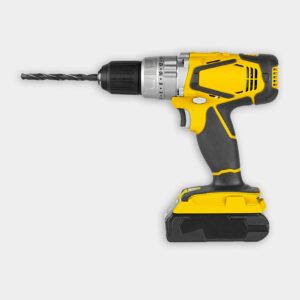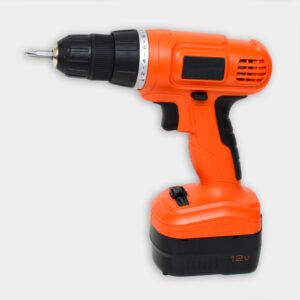We may be compensated if you purchase through links on our website. Our team is committed to delivering honest, objective, and independent reviews on home products and services.
A drill/driver is arguably the most versatile and important power tool for your home toolkit. This multipurpose device can drill holes, drive screws, and even tackle masonry work with the right attachments. In the video above, Ask This Old House general contractor Tom Silva breaks down the key features of the modern drill/driver to help you get the most out of the tool.
Drill/Driver Basics
Before you get into using a drill/driver, it’s good to understand the key parts and what they do. This helps you use the tool more effectively and confidently.
Main Parts
A typical drill/driver consists of several key components:
- Chuck: Holds the drill bit or screwdriver bit.
- Clutch: Adjusts torque (the twisting force) to avoid stripping screws.
- Forward/reverse switch: Changes the direction of rotation, especially useful for driving and removing screws.
- Mode selector: Switches between drilling, driving, and (on some models) hammer drilling.
- Speed selector: Lets you toggle between high and low speeds.
- Trigger: Controls the tool’s speed.
These components work together to make the drill/driver versatile for many tasks. For example, you’ll use the forward/reverse switch to back out screws or drill bits, and the clutch helps prevent over-torquing when driving screws.
Types of Drill/Drivers
There are several types of drill/drivers available on the market:
- Corded drill/drivers: Offer consistent power but limited mobility because of the cord.
- Cordless drill/drivers: For portability and convenience.
- Hammer drill/drivers: Designed for tougher jobs like drilling into masonry (stone, concrete, brick).
- Impact drivers: Deliver high torque for driving large fasteners
Cordless models are the go-to for most homeowners because they’re portable and powerful enough for a wide range of tasks. Corded models, while less mobile, are great for continuous heavy-duty work. If you’re dealing with tough materials like concrete, a hammer drill/driver or impact driver may be the better choice.
Choosing the Right Drill/Driver for the Job
Picking the right drill/driver depends on what you plan to use it for. Here are a few factors to keep in mind.
Power and Voltage
The power of a cordless drill/driver is measured in volts. Higher voltage typically means more power and longer battery life. For most home improvement jobs, like hanging shelves or assembling furniture, a 12V or 18V drill/driver should suffice. But if you frequently finish heavy-duty work such as masonry drilling or large-scale woodworking, a 20V model may be a better fit.
Chuck Size
The chuck size determines the maximum diameter of the drill bit or driver bit you can use. A 3/8-inch chuck is great for most home projects, while a 1/2-inch chuck handles larger bits for bigger jobs. Some professional models even go up to 5/8-inch for more specialized work.
Battery Type
Look for models with lithium-ion batteries, which offer longer run times and quicker charging compared to older nickel-cadmium batteries. If you’ll be working on bigger projects, choose a model with removable batteries so you can keep a spare charged and ready to go.
Extra Features
Some drill/drivers come with additional features that make them easier to use:
- Brushless motors: More efficient and longer-lasting.
- LED work lights: Helps illuminate darker areas while you work.
- Keyless chucks: For faster bit changes.
- Multiple speed settings: Gives you more control for different tasks.
Using a Drill/Driver Effectively
Now that you understand the basics of drill/drivers, it’s time to get to work. Here’s how to use it properly for both drilling holes and driving screws.
Setting Up the Drill/Driver
Before starting any task, make sure your drill/driver is correctly set up. Follow these steps:
- Insert the appropriate bit into the chuck.
- Adjust the clutch based on the task—lower settings for small screws, higher for larger ones.
- Select the right speed: use high speed for drilling and low speed for driving screws.
- Choose your mode: drilling, driving, or hammer drilling (if available).
- Set the forward/reverse switch to the direction you need.
Drilling Holes
When drilling holes, follow these steps:
- Mark the spot where you want to drill.
- Set the tool to the drilling mode.
- Choose a high-speed setting for smaller holes or a low-speed setting for larger holes.
- Apply steady pressure and let the drill do the work.
- Pull the bit out occasionally to clear any debris and prevent overheating.
Driving Screws
For driving screws, use these techniques:
- Set the tool to driving mode.
- Adjust the clutch to a low setting for small screws or a higher setting for larger screws.
- Use a low-speed setting for better control.
- Apply steady pressure and let the tool drive the screw.
- Stop when the clutch disengages to avoid overdriving or stripping the screw and damaging your workpiece.
Advanced Drill/Driver Tips for Better Results
As you become more comfortable with your drill/driver, you can explore these advanced techniques to improve your skills.
Mastering Variable Speed Control
The variable speed trigger allows for precise control over the drill/driver’s speed. Practice using light pressure for slow speeds when starting holes or driving screws. Gradually increase pressure for faster speeds as needed. This gives you more control and precision.
Switching Between Drilling and Driving
Many modern drill/drivers allow for quick switching between drilling and driving modes. Familiarize yourself with this feature to seamlessly transition between tasks without changing out your tools. This capability can drastically reduce your workload and time spent on projects that require both modes, like hanging wall fixtures where you need to drill pilot holes and drive screws.
Efficient Bit Changes
If you’re switching between bits frequently, a drill/driver with a keyless chuck will save time. You won’t need to hunt for a key to tighten or loosen the chuck—just twist it by hand to switch bits quickly.
Drill/Driver Maintenance and Safety
Taking care of your drill/driver and following basic safety practices will keep your tool working well and help avoid accidents.
Maintaining Your Drill/Driver
Here are a few tips to keep your tool in pristine condition:
- Keep the tool clean and free of dust and debris.
- Regularly check and tighten any loose parts.
- Store the drill/driver in a dry place when you’re not using it.
- Follow the manufacturer’s instructions for battery care and charging to extend the battery’s lifespan.
Drill/Driver Safety Precautions
When using a drill/driver, always:
- Wear safety glasses to protect your eyes from debris.
- Use appropriate hearing protection in noisy environments.
- Keep loose clothing, jewelry, and long hair away from moving parts.
- Secure your workpiece to prevent slipping or spinning.
- Unplug corded tools or remove the battery from cordless tools when changing bits or making adjustments.


